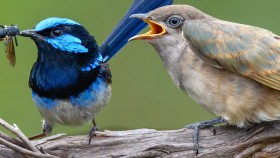Wrens prove there’s safety in numbers
Australian superb fairy-wrens learn how to recognise threats to their species through social learning.
Research from the ANU has found the first direct evidence that naïve hosts learn from their acquaintances to identify enemies such as brood parasites.
Brood parasites camouflage their own eggs in wren’s nests so they don’t have to look after the eggs themselves.
Experiments were conducted in Canberra’s Campbell Park during September to November last year and tested whether superb fairy-wrens acquired a mobbing response to shining bronze-cuckoos and white-plumed honeyeaters.
“Superb fairy-wrens produce a ‘whining’ alarm call exclusively in response to cuckoos, and are likely to use it reliably because it recruits group members and neighbours to assist in mobbing of cuckoos,” said William Feeney of the Langmore Lab, Research School of Biology PhD student and co-author of the research paper.
“Recognition of an adult cuckoo can result in successful deflection of parasitism, or more accurate decisions about rejection of cuckoo eggs and chicks.”
The tests were done in three stages – an individual pre-training trail (where a single wren was shown a model of a cuckoo or honeyeater), a training trial (where a model cuckoo or honeyeater was shown to an entire group of wrens), and a post-training trial (where a model was shown to the same previously naïve wren, again when it was alone).
Where possible all three treatments were done in the one day and trials recorded the level of mobbing and whining calls when at least one training wren came within two metres of the model.
“At first Cuckoo-naïve superb fairy-wrens were unresponsive to cuckoo models in the pre-training trails,” Mr Feeney said.
“However, following training by group members, these individuals produced significantly more whining and mobbing alarm calls and spent significantly more time within 0.5 metres of the model in response to the cuckoo.”
Mr Feeney said learning from peers gave a clear advantage to the individual.
Mr Feeney’s full study has been published in the latest issue of Biology Letters, released this week. Click here to read the paper Social learning of a brood parasite by its host in full.
Source: Wrens prove there’s safety in numbers ANU News.
Photo: Peer learning helps wrens protect their nest from predators, new research from the ANU has found. Photo: William Feeney.
Related links







